How to handle the force and strain that using medium-sized hose exerts on a firefighter’s body
The medium-diameter hose coming off the bed often indicates that a fire is beyond our means to extinguish quickly, a fire is getting out of control, or there is a marked tactical change from offensive to defensive. In other words, except for fires that are clear-cut 2½-inch candidates from the start, it is rarely a sign that things are going our way. In addition, many times when the 2½-inch is being deployed—not for exposure protection but to affect extinguishment—crews have already been working under arduous conditions for some time.
Fires in frame dwellings (row or otherwise), occupied multiple dwellings, or small- to mid-size commercial occupancies that require deploying this hoseline all generally have one thing in common: a very significant amount of fire. You can expect in such instances that the fire has damaged, degraded, and dismantled much of the building’s contents and structural members. Even in an “open floor” plan building, we expect to struggle with that 2½-inch through a significant debris field. With that in mind, we can do a few things to make the deployment of 200-plus gallons per minute (gpm) more efficient and easier.
Recognizing the Struggle
The phrase “Big fire, big water” is mostly taken as gospel, but what is often overlooked regarding that statement is that there is often a correlation between the need for “big” water and the struggle of getting it to where it needs to be. Realizing that you may have an exceedingly difficult time getting big water to the fire can be a game changer. As mentioned above, many times, we are not deploying the line over a nice, neat, unencumbered concrete floor. In stores, we are often obstructed by knocked-over racks, burnt-out display cases, and fallen drop ceiling tiles. In residences, we face turned-over furniture; tight turns; pack-rat conditions; personnel clogging the attack path; and, again, destroyed building components. These factors often combine to produce a situation where the fire gains headway while we struggle to get that big line into an advantageous operating position. “Calling the stretch,” as it is often referred to, is not enough in these instances. More important is understanding the problem before you and taking the all-important first step in making it better: getting help. An adequately staffed engine crew can advance this line in a moderate fashion under good conditions while being unencumbered. In reality, the crew will be bogged down and in need of help.
RELATED FIREFIGHTER TRAINING
- Fredericks: The 2 1/2 Inch Handline
- Systematic Views of the 2 1/2-Inch Handline in Fire Attack
- “Big Fire, Big Water”: The 2½-Inch Hoseline
Envision any building in your district that would be a prime candidate for such a problem. An example from the Jersey City (NJ) Fire Department’s 4th Battalion would be any number of three-story Class 5 mixed occupancies with a store on the first floor (photo 1). Many times, the apartments are further subdivided and packed to the brim. (In one such building at an unattended cooking call, I opened a closet to discover two sets of bunk beds with four grown men relaxing therein.)
A large body of fire in a store and one floor above would be a textbook (but maybe not real-life) indicator of calling for that 2½-inch; if it were for mere “punching power,” the call would be correct. However, the immense struggle in traversing such a mess just to get big water to the seat could be nearly insurmountable for even an adequately staffed engine.
Sidestepping the debate of what line gets put into play here, the point is that if the call for the big line gets made in such an instance, the attack engine needs help. The adjacent engine can help stretch in, clear debris from the path, uncover the seat, or otherwise do anything necessary to get that tank water onto the seat of the fire. For a large body of fire, the second engine, which generally establishes a water supply, may have to wait to do so or call on an arriving unit to assist the pump operator in laying the water. This potentially costly maneuver is justified for the mere fact that establishing positive water is utterly meaningless if the attack line cannot get any of the water at the fire area.
Continued water is necessary for the ongoing operation, the safety of crews, timely extinguishment, protection of search operations, securing exits, and the like, so make every effort in this regard, but the “first 500” belong solely to those who may be inside and need our undivided and immediate assistance, be it at the seat or for protecting rescues. If the first engine needs help getting those tank gallons to where they are most needed, as can be the case with the 2½-inch, the second-arriving crew needs to help—immediately!
The first-arriving ladder company, being dedicated to search, entry, ventilation, location, and life hazard, is often stretched thin to begin with (especially in municipalities with three or four members on a truck). That said, if they see or hear that the first line being put into play is a big one, they should make every effort to assist in its deployment so long as it does not take away from the dedication to life hazard.
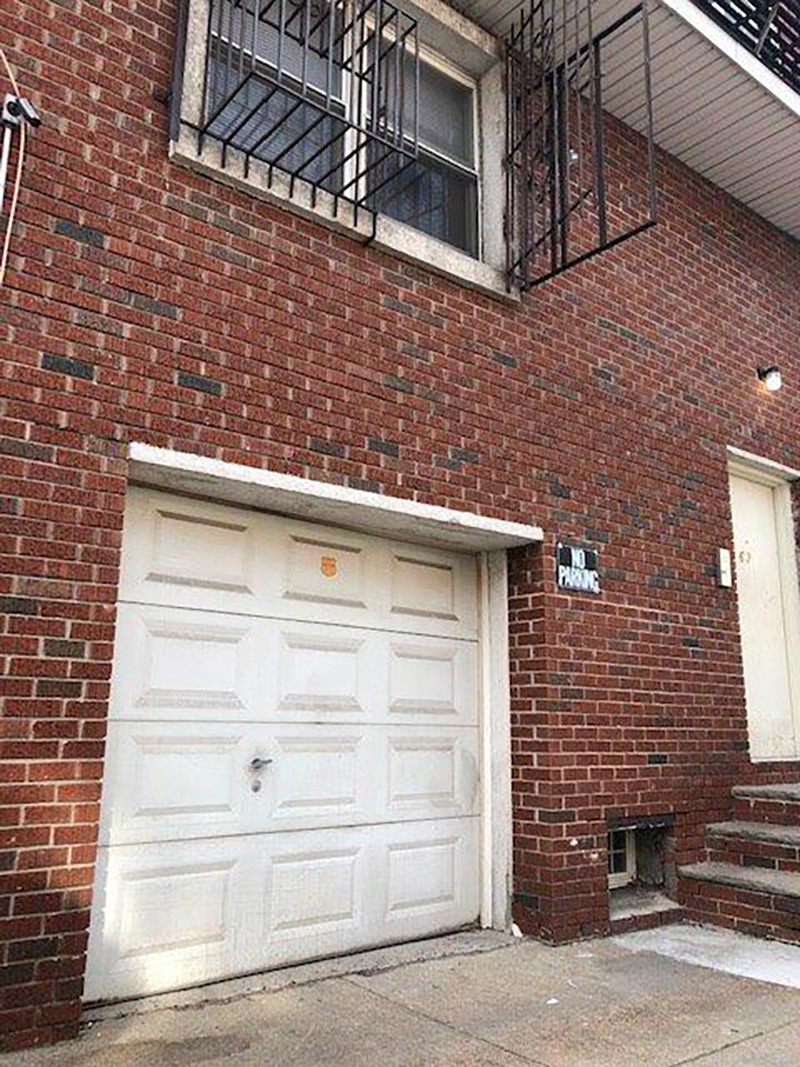
(1) Photos by author.
Managing the Struggle
Continued operation on the offensive side of a fire with the 2½-inch line is backbreaking labor. Struggling to pull the line and flow more than 200 gpm is no easy task. As important as it is to stretch wide around bends, minimize turns, and keep the nozzle at arm’s length with the 1¾-inch, it is exponentially more important to do so with the 2½-inch.
Before entering a large apartment, flake the line nearly to the end of the hall opposite the direction of your anticipated travel before you open the door. For example, if the large line is staged to attack at a common landing, and the officer or a ladder crew knows that you will be traveling primarily left behind the door, bow and flake the charged line (photos 2, 3) as far as possible down the right side of the hall.
Another example would be a large storefront that is far longer along the street than it is deep. Seeing a large body of fire toward one side would necessitate bowing and flaking a long distance at the street opposite the direction of the push. Charging at the door and trying to make a hard right/left turn will not do. We can overcome these oversights with the small line but not so with the 2½-inch.
A charged advance must occur in unison more than ever with this line; it sounds fairly simple, but it is often lost amidst the cacophony and mayhem of a fire. Whereas an advance with a 1¾-inch line feels almost like a continuous movement, with members crawling along in fluid motion, a 2½-inch advance sometimes resembles more of a large victim drag. Members often pull in short, stunted bursts. In this regard, an under-leg hip advance, done by at least two members, is an excellent way to move the line quickly without wasting effort—or air (photos 4-6). With members on the same side of the line, the nozzleman has a section of line across his chest with his left leg slightly raised and the trailing line under his crotch. His right leg is tucked under his left thigh so that his shin rests on the line. The second member on the line, perhaps half a length back, mimics this maneuver, and members advance together; they will be using their core and hips to move the line as they push forward and pull their hips and trail leg with them. This will pay big dividends in terms of how long your team will be able to operate in the immediately dangerous to life or health atmosphere.
To have two members advance smoothly in such a fashion takes some doing, but it is superior to pulling with arms, yelling for more line, and trying to just muscle the big line over long distances. Where air conservation matters, so too does working smartly.
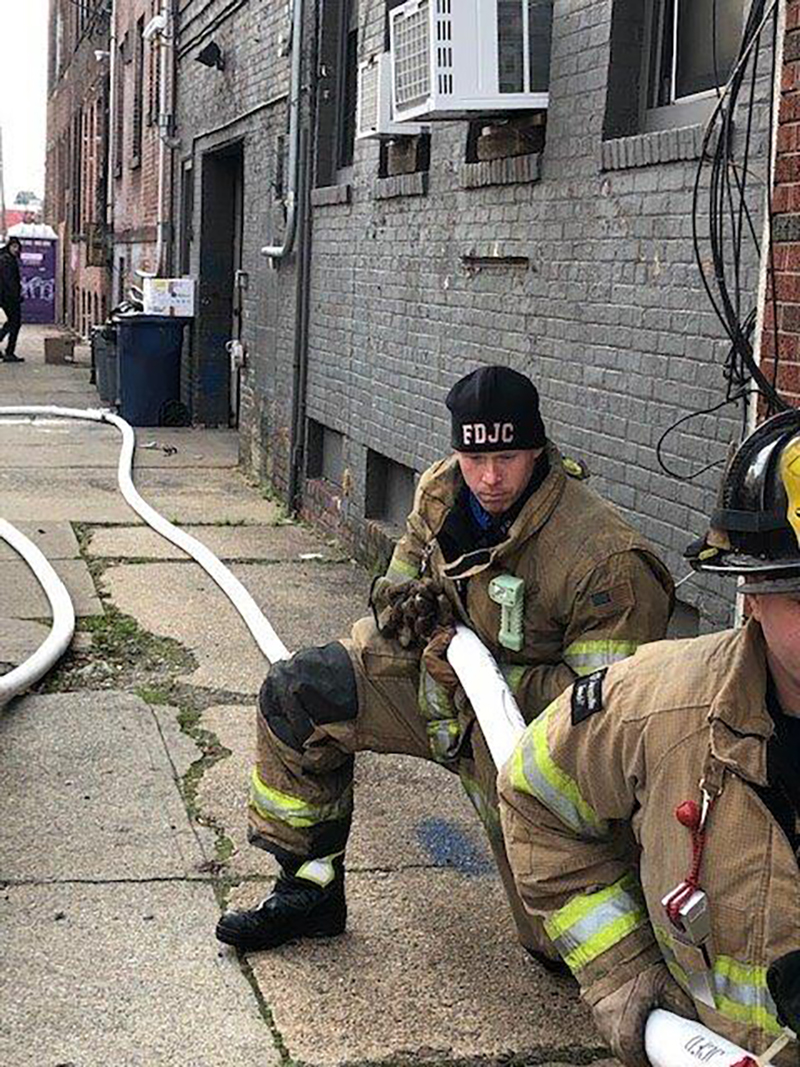
(2)
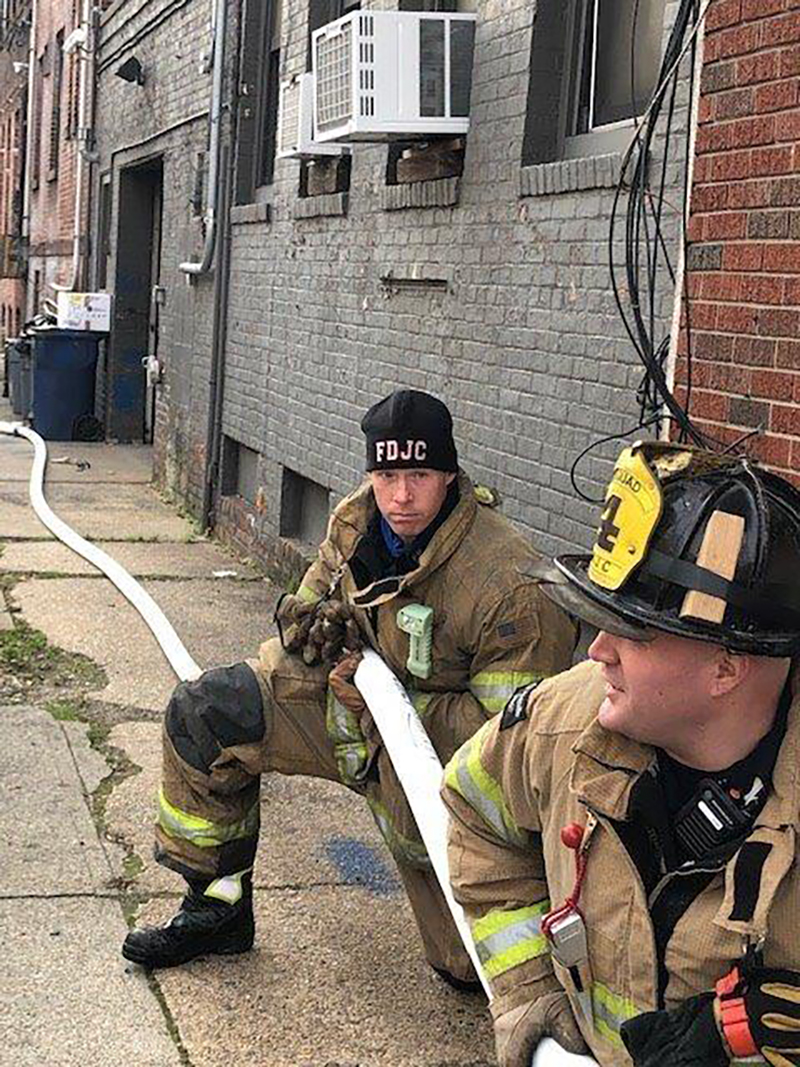
(3)

(4)
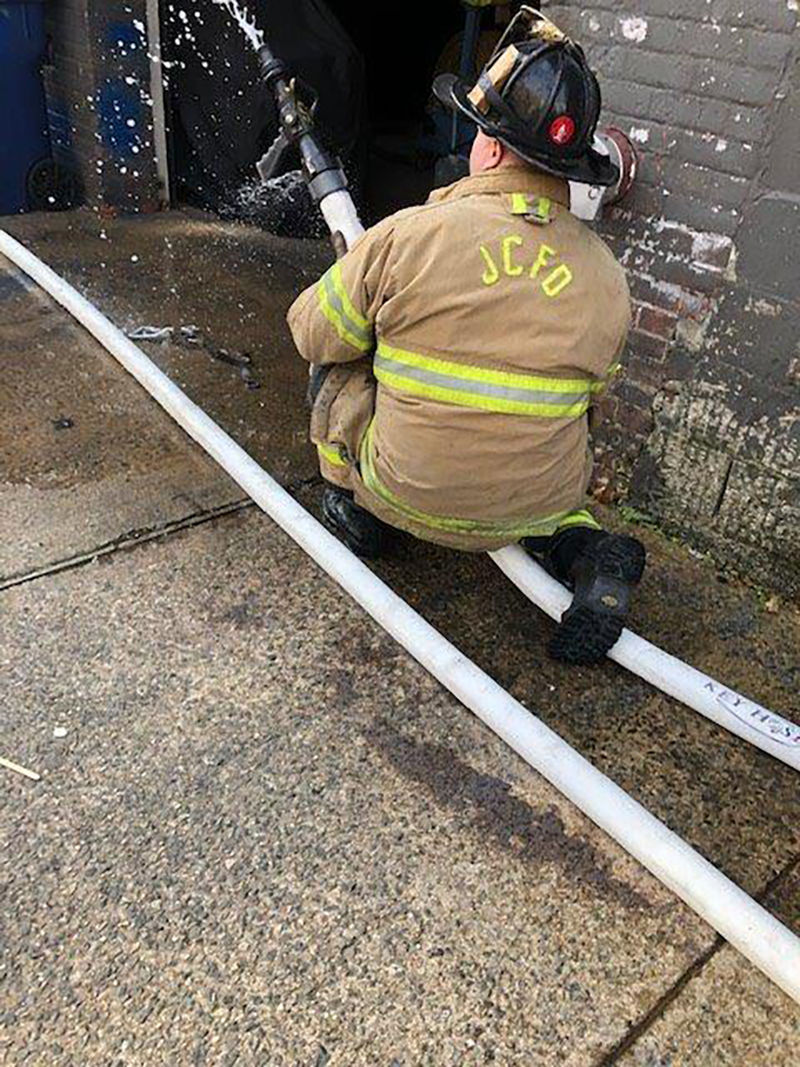
(5)
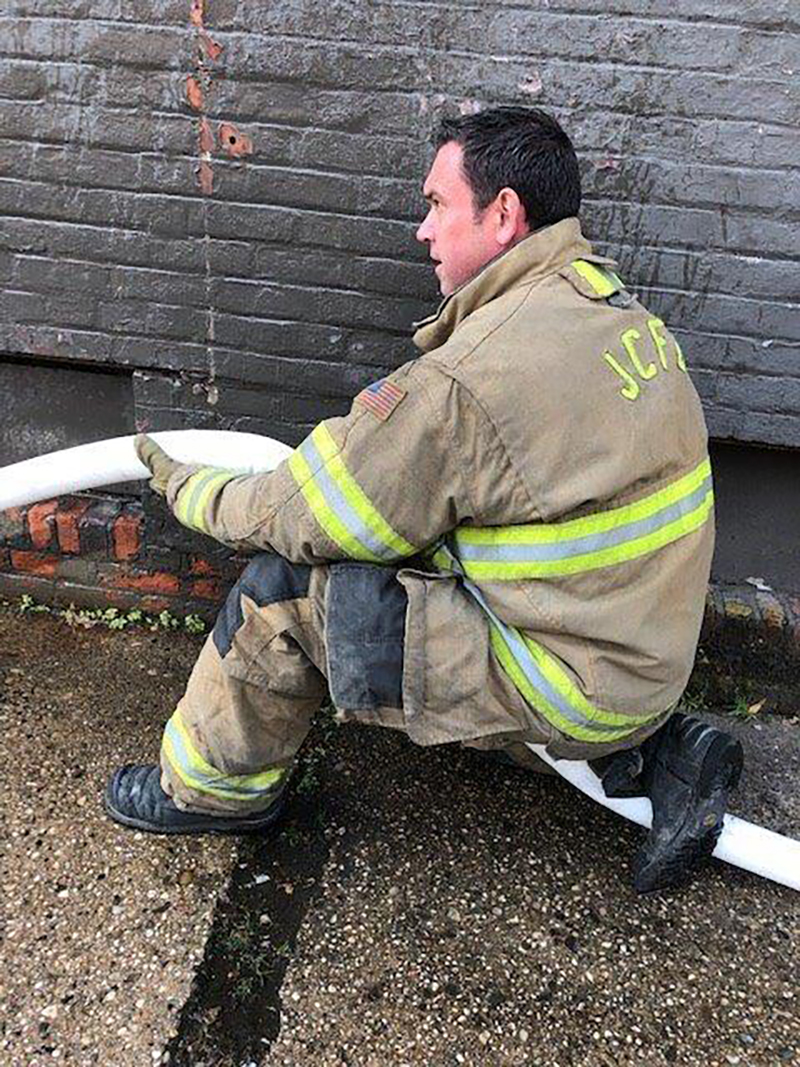
(6)
Flowing Fluidly
A well-charged 2½-inch line with a smooth bore 1¼-inch tip can discharge upward of 225 gpm. Without getting bogged down with the math, we know that the nozzle reaction on a smooth bore is considerably less than with a combo nozzle—that is, until the point of overpressurization. Once the smooth bore becomes overpressurized, the nozzle reaction grows at a rate that is alarmingly faster than that of an overpressurized fog counterpart. This is important to recognize with the big line because, at many large-scale fires, engines are operating with multiple lines of multiple diameters with varying tip sizes. Different mains, variances in the pumps, broken transfer valves, and any number of factors can contribute to cause a wide disparity in the “push back” of the 2½-inch. Even the most conscientious pump operator can sometimes be left powerless to control what is being thrown into that line.
On the other end, the most robust nozzle operator cannot meet every need with “gate it down.” Even a line flowing properly over a long period of time becomes very difficult to operate. Sitting on a 2½-inch in the street, wetting down an exposure, and not moving is one thing; attacking offensively with it is another thing entirely.
By placing the strain of the advance on the body’s larger muscles, we can achieve a similar effect with flowing the nozzle. To do this, all that is needed is a hose strap (yes, they still have their place) or a piece of webbing and your two-point seated bailout harness. The nozzle operator can wrap the line just behind his hip and clip it directly into his harness. Note that this move works far more securely if the rated harness has a large carabiner you can clip directly into the handle of the hose strap or piece of webbing (photos 7, 8); the backup member can do the same if needed.
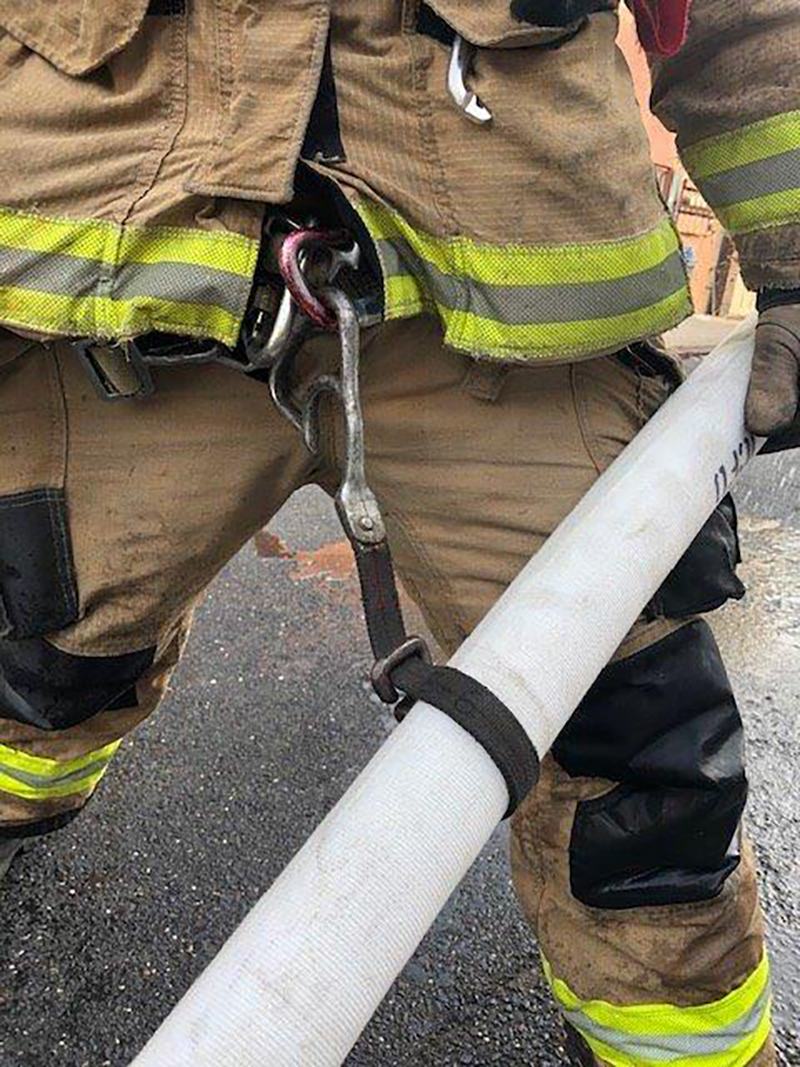
(7)

(8)
The nozzleman then braces himself against the nozzle reaction; in many instances, he can achieve some flowing during the advance. In fact, advancing in short pushes this way works quite well, especially when advancing upward or trying to flow the line upward from a stairwell. With the line directly affixed to your harness, the nozzle reaction is absorbed and distributed more by your core muscles. Put simply, you will exert better control over the line and be able to move it more easily.
Keep in mind that securing the line to yourself merely to advance it should not often be needed, but bracing against a considerable nozzle reaction, hitting the fire, shutting down quickly, and moving again could be needed and very helpful.
It is also worth noting that affixing yourself to the line carries with it some degree of hazard. Should the nozzle be lost or the line burst, you could be “going for a ride.” If the line slides down a hole in the floor, be cautious so as not to go with it. For reasons like these, it is good practice to limit “clipping in” for when you are nearly stationary, are without significant help, or have very good visibility and no apparent problems before you. Again, communication with the entire crew is going to be critical in such instances.
Gating Down: Not an Option
Other than dealing with a totally out-of-control line that cannot be reduced in pressure though outside communication, gating down a 2½-inch is even more problematic than the smaller line. For starters, partially closing the bail of a smooth bore creates more turbulent flow; the water flow narrows toward the tip, and the water bounces off itself more than it should. The result is a “spitting” action, a weaker stream, and less gallons but a more manageable line; this is mostly unacceptable. The larger line was selected specifically because more water was needed, so gating it down often defeats the purpose in struggling to get more water where it is needed.
Gating down a fog nozzle decreases the force with which the water is thrown into the baffle. Whether on a straight stream or fog, the result is the same: less water when more is needed. Saying “I can’t hold it” means you need to get help or help yourself in one of the aforementioned ways, not “apply less water.” Applying less water is only acceptable if the other option is a lost line, no water, burst length, or injury.
Operations where the big line is the main player are anything but ordinary; they are large scale, need a tactical change from offensive to defensive, need extended operations, and so on. To the aggressive attack crew, realizing that an immediate knockout is not achievable is defeating. Realizing that an offensive operation is needed with larger lines requires that we bear down, work cohesively, take every advantage afforded to us, and work smarter.
We may not be able to change the “down-and-out” feeling that sometimes accompanies deploying these large lines, but we can manage our effectiveness with them. Sometimes, we need the line that is the hardest to work at the hardest of fires.
ALEXANDER DEGNAN is a 16-year member of the Jersey City (NJ) Fire Department (JCFD), where he is the captain of #618 Squad Co. 4, a position he has held since 2015. Prior to his captain’s position, he was a 10-year firefighter with the JCFD’s #1013 Squad Co. 4.

